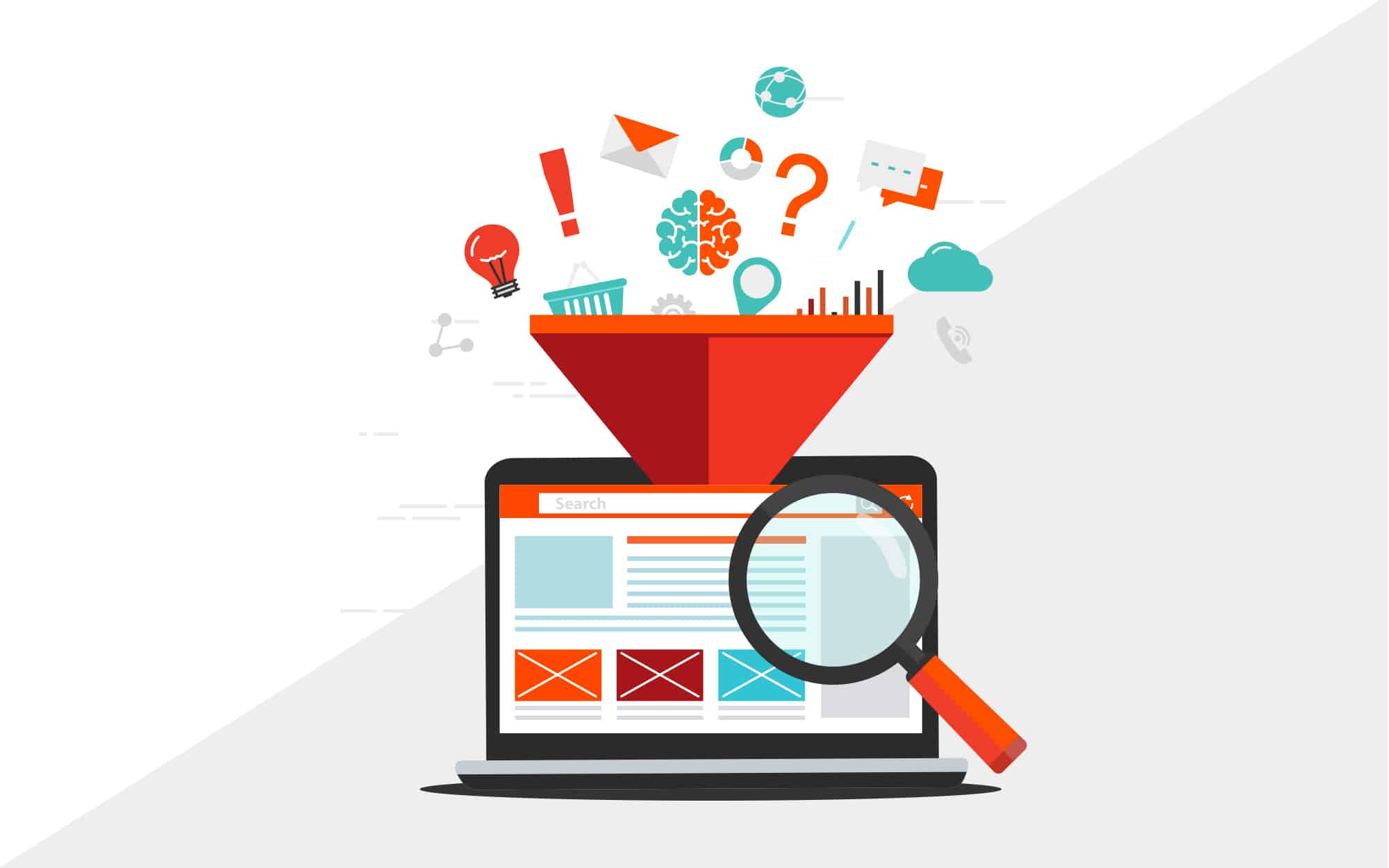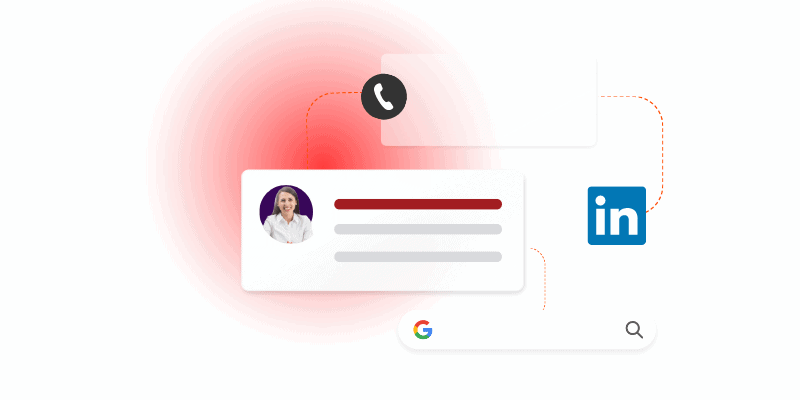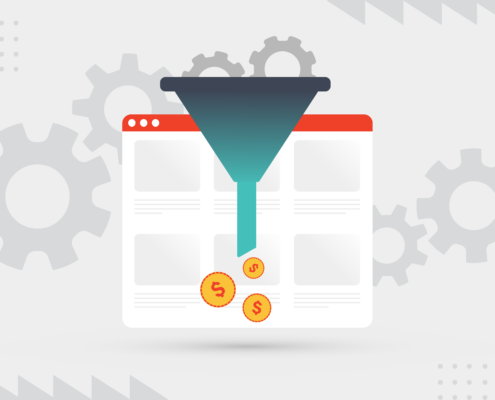

Many businesses want to approach their target audience head-on, but often don’t know where to start. Sound familiar to you? If so, we might just have the answer for you—outbound lead generation.
Outbound lead generation is one of two main B2B lead generation strategies that sales and marketing teams can follow to fill their sales pipelines and convert more prospects into closed sales opportunities.
In this blog, we’ll cover the following topics regarding outbound lead generation:
- Definition of Outbound Lead Generation
- How B2B Outbound Lead Generation Works
- Outbound vs. Inbound Lead Gen: What’s the Difference?
- Best B2B Outbound Lead Generation Methods
- Benefits of Implementing an Outbound Lead Generation Strategy
- Ways to Improve Your Outbound Lead Generation Strategy
- Who Is Involved in a B2B Outbound Lead Generation Team?
- Reasons to Outsource Your Outbound Lead Generation Strategy
Definition of Outbound Lead Generation
Outbound lead generation is a marketing and sales strategy focused on proactively reaching out to potential customers or leads who may have an interest in a company’s products or services.
This approach involves initiating contact with individuals or businesses through various means, such as cold calling, cold emailing, social media outreach (or social selling) and more. The ultimate goal here is to generate interest, qualify prospects, and ultimately convert them into paying customers or clients. For many sales development teams, this process is crucial to building and maintaining a robust, predictable, and sustainable sales pipeline.
How B2B Outbound Lead Generation Works
Outbound lead generation involves a systematic approach to identifying, contacting, and converting potential leads into customers through proactive outreach. Here’s a step-by-step breakdown of the outbound lead generation process:
- Define target audience
- Build a prospect list
- Segment leads based on similar characteristics
- Craft compelling messaging and sales pitch
- Initiate contact and introduce business
- Respond to questions and overcome objections
- Qualify leads based on their sales criteria and buying readiness
- Nurture qualified prospects until they’re ready to buy
- Persistently follow-up with leads who are closer to the end of the sales cycle
- Secure qualified sales meetings with verified decison-makers
- Consistently track and analyze results
- Optimize and refine your outbound lead gen strategy as needed
Outbound lead generation can be a dynamic and ongoing process, and it requires a well-coordinated effort between lead generation, marketing, and sales teams to generate and convert leads effectively. It’s important to strike a balance between persistence and respecting the preferences and boundaries of your leads to build positive relationships.
How Does Outbound Lead Generation Align With Sales?
Outbound lead generation aligns with sales by proactively identifying and engaging potential customers through various outreach methods. It serves as the initial touchpoint in the sales process, aiming to stimulate interest and qualify prospects. This alignment ensures that the sales team receives a steady stream of leads that have shown some level of interest or fit specific criteria.
By focusing on outreach, lead qualification, and relationship-building, outbound lead generation allows the sales team with a full pipeline of potential customers, empowering them to close more deals and drive revenue for their business.
Our B2B appointment setting solution empowers growing businesses to spend more time selling, and less time prospecting and nurturing relationships with qualified prospects. Learn about our proven-effective approach to outbound lead gen here.
Best B2B Outbound Lead Generation Methods
The effectiveness of different outbound lead generation methods can vary depending on the industry, target audience, and specific goals of a business. What works best for one organization may not be as effective for another.
However, some outbound lead generation methods have consistently shown good results when executed well. Here are some of the best outbound lead generation methods:
Cold Calling
Cold calling is incredibly effective when executed strategically. It provides immediate direct engagement with potential clients, allowing for real-time dialogue and relationship-building.
Although it faces challenges like rejection and skepticism, it offers advantages such as immediate feedback, the opportunity to uncover hidden needs, and the ability to tailor the sales pitch on the fly. In industries where personal relationships play a vital role, cold calling can establish a strong initial connection.
However, its success depends on skilled sales development representatives (SDRs) who can empathize with prospects, convey value effectively, and follow up diligently, making it an essential component of a comprehensive B2B lead generation strategy.
Cold calling is a tough skill that many SDRs struggle to get the hang of. Download our free guide here to gain insight into the latest cold calling best practices.
Cold Emailing
Cold emailing is highly effective because it allows for a structured and personalized approach, enabling businesses to reach a large number of prospects at a relatively low cost.
With careful targeting and compelling messaging, cold emails can pique the interest of potential clients, leading to meaningful conversations and opportunities. Additionally, email automation tools can streamline follow-up and nurture sequences, ensuring consistent engagement.
However, success hinges on crafting engaging subject lines, delivering valuable content, and adhering to email regulations. When executed strategically, cold emailing can be a scalable and efficient method for generating B2B leads and building relationships over time.
Social Selling
Social selling (or social media outreach) is highly effective because it leverages social media platforms like LinkedIn, Twitter, and other outreach-encouraged platforms as powerful tools for relationship-building and lead generation. By engaging with potential clients through content sharing, commenting, and direct messaging, businesses can establish trust, demonstrate expertise, and nurture connections.
Social platforms provide valuable insights into prospects’ interests and behaviors, enabling more targeted and personalized outreach. Moreover, it aligns with modern buyers’ preferences for researching solutions online, making it a non-intrusive way to reach potential clients. When executed thoughtfully and authentically, social selling can lead to meaningful B2B relationships, increased brand visibility, and ultimately, a boost in sales and revenue.
Multichannel Approach
A multi-channel approach in outbound lead generation refers to the practice of utilizing multiple communication channels and marketing methods to reach potential leads and engage with them effectively. Instead of relying on a single method, businesses diversify their outreach efforts to connect with a wider audience and accommodate varying preferences. This approach recognizes that different prospects may be more receptive to certain channels or modes of communication.
For example, a multi-channel outbound lead generation strategy might involve a combination of:
- Cold calling — Reaching out to leads via phone calls
- Cold email marketing — Sending targeted emails to prospects
- Social selling — Engaging with potential leads on social media platforms
By employing this diverse set of channels, businesses increase their chances of capturing the attention of potential leads and can adapt their approach to better resonate with different audience segments. A multi-channel approach helps maximize outreach, improve brand visibility, and enhance the overall effectiveness of outbound lead generation efforts.

Benefits of Implementing an Outbound Lead Generation Strategy
Implementing an outbound lead generation strategy can offer several significant benefits to a business:
- Increased sales: The most direct benefit is an increase in sales and revenue. Outbound lead generation actively identifies and engages potential customers, which can result in more closed deals and higher profits.
- Broader market reach: It allows a company to expand its reach beyond its existing customer base. By proactively seeking out new leads, businesses can tap into new markets and customer segments.
- More targeted audience engagement opportunities: Outbound strategies often involve careful segmentation and targeting. This means you can focus your efforts on the most promising leads, increasing the likelihood of conversion.
- Enhanced lead qualification: Outbound strategies typically involve an initial qualification process. This means that by the time a lead reaches the sales team, they are more likely to be genuinely interested and potentially ready to make a purchase.
- Greater competitive advantage: A well-executed outbound strategy can help a business stand out in a crowded marketplace. It showcases your products or services directly to potential customers, giving you a competitive edge.
- Boosted brand awareness: Outbound methods create brand visibility and awareness, even among those who may not be immediate buyers. This can lead to future business as prospects become more familiar with your company.
- Better data and insights: Outbound lead generation generates valuable data on customer preferences, responses, and market trends. This information can inform future marketing and sales strategies.
- More efficient sales pipeline management: Outbound strategies help maintain a consistent flow of leads into the sales pipeline, reducing the risk of sales team downtime and ensuring a steady stream of potential customers to engage with.
- Greater ability to adapt: Outbound strategies can be adjusted and optimized based on real-time feedback and performance metrics, allowing for continuous improvement.
- More diversification: By using multiple outbound channels, businesses can diversify their lead sources, reducing dependency on a single marketing method.
- Stronger relationship building: Effective outbound lead generation involves building relationships with prospects. Over time, these relationships can lead to repeat business, referrals, and brand loyalty.
- Deeper market research: Engaging with potential customers through outbound methods can provide insights into their pain points, needs, and preferences, which can inform product development and marketing strategies.
An outbound lead generation strategy can help a business grow, increase revenue, and build lasting customer relationships. However, success in outbound lead generation depends on a well-planned, data-driven approach that is executed skillfully and ethically to provide real value to potential customers.
Ways to Improve Your Outbound Lead Generation Strategy
Companies can enhance their outbound lead generation strategy in several ways to increase effectiveness and drive better results. Here are a few of the most impactful ways you can improve your outbound lead generation approach:
Refine Your Targeting Strategy
Refining your target strategy is essential for engaging the right (and best leads) and the right time. Therefore, you must invest time in identifying and refining your ideal customer profile (ICP). This ensures that your outreach efforts are directed toward prospects who are more likely to convert into customers, reducing the amount of time they spend in the sales cycle.
Routinely Check Data Hygiene
While investing in sales prospecting software is incredibly valuable for filling your sales pipeline with potential buyers, the data in these prospect lists aren’t always up-to-date with the latest decision-maker contact information. Therefore, it’s important that you acquire high-quality lead lists and maintain accurate contact information by reaching out to the contact and confirming who the best decision-maker is for your company’s product or service offering. Regularly updating and cleaning your databases minimizes wasted outreach efforts on incorrect or outdated prospect accounts.
For more insight on how to effectively ensure clean data hygiene, read our blog here.
Personalize Messaging Based on the Prospect
Every prospect in the sales pipeline has different needs, so it’s vital to personalize content, messaging, and sales pitches based on the specific lead and their wants, needs, and interests. Crafting these aspects of your outbound lead generation strategy empowers you to further pique the interest of potential buyers, encouraging them to feel more connected with your business.
A/B Test Different Messaging and Pitch Strategies
You never know what works for your target audience until you try something out, and sometimes that means trying a few different approaches at once to see what clicks and what doesn’t. Continuously testing different messaging, subject lines, and outreach approaches can help you determine what resonates best with potential buyers, potentially resulting in quicker turn times. When A/B testing different content, use the insights gained to refine your strategy and engage more leads.
Implement a Multi-Channel Approach
An outbound lead generation strategy is only as strong as you make it. And to make it stronger and convert more leads over time, you must implement a variety of outbound lead generation strtegies. A diverse outreach approach increases your chances of connecting with leads on their preferred platform, whether it’s via phone call, sales email, or LinkedIn outreach. This empowers your sales development teams to reach all the different buyer personas within your target market, resulting in higher quality leads generated.
Make Sure Sales and Marketing Are Aligned
Sales, marketing, and lead generation alignment is crucial for an effective outbound lead generation strategy. Outbound lead generation teams serve as a liaison between sales and marketing to explore and implement what’s working from the marketing side, and what’s converting from the sales side. Fostering close collaboration between your sales and marketing teams ensures that both departments are aligned on goals, messaging, and lead qualification criteria.
Establish a Lead Scoring Technique
Implementing a lead scoring technique can help you prioritize leads based on their likelihood to convert. This helps your sales team focus their efforts on the most promising prospects, reducing the risk of wasting time on leads who are unlikely to buy any time soon.
Integrate Sales Technology With Your CRM
Outbound lead generaton has evolved quite a bit over the years, meaning old school techniques aren’t impactful for a building and maintaining a business growth solution that yields results. One of these evolvements of outbound lead gen includes the integration of sales tool and technologies, and their ability to integrate with your company’s customer relationship management (CRM) software.
Viable outbound sales development tools include sales prospecting software to help with list building, a lead management system to automate tedious tasks such as sending follow-up emails, and a CRM to keep it all in a unified location. This allows your SDRs to spend more time talking one-on-one with prospects and following up with the most buying-ready leads, leading to stronger relationships built.
What role does your CRM play in B2B lead generation? To learn how to effectively integrate your CRM with your business growth efforts, read our blog here.
Create a Valuable Content Marketing Strategy
For an outbound lead generation strategy to be effective, you must develop valuable content that addresses common pain points and challenges faced by your target audience. Then, you must share this content through various channels to establish expertise and further engage prospects.
For example, let’s say that you’re a commercial solar company that wants to convert more businesses into investing in solar panels for their office buildings. If a prospect says they’ve considered it but want more time to think it over, your SDRs can send them different content marketing materials such as blog posts or infographics that talks about the benefits of investing in solar, such as cost savings, its environmental impact, etc.
Then, if they’re still not ready to convert, a follow up asset when they’re in the consideration stage of the sales funnel could be a case study showcasing the impact your commercial solar company has made on businesses in the same industry as the prospect, encouraging the decison-maker to envision themselves as your client.
Evaluate Your Follow-Up Campaign Sequences
As we touched on earlier, follow-up sequences are vital for keeping your business top-of-mind and driving prospects further down the lead generation and marketing funnel. However, these follow-up campaigns can be tedious for SDRs and takes away time from building stronger relationships with prospects.
If you want to get the most benefits from your follow-up sequences, you must implement automated processes to maintain engagement with leads who may not be ready to convert immediately. This is what makes lead segmentation so important for outbound lead generation, because whether you segment leads based on industry, stage in the sales funnel, etc., it ensures you send the best content to the right leads, progressing their journey to conversion.
Use Analytics and Tracking to Improve Your Approach
Without outbound lead gen metrics, analytics, and tracking, you’re going in blind with your business growth efforts, not evaluating what works and what doesn’t. Therefore, you must use data to measure the performance of your outbound efforts. A few key metrics to track for outbound lead generation include response rates, conversion rates, ROI, and more. By tracking this data, you have a greater opportunity to identify areas for improvement.
Invest in Continuous Sales Training
What may work for outbound lead generation at one point in time may not work forever. Therefore, it’s important to consistently train your sales development, sales, and marketing teams on the latest best practices to ensure you get the best results from your business growth efforts.
This training can also revolve around ways SDRs, sales execs, and marketing experts can continue to grow in their specific roles and careers. For example, if you see that an SDR may be falling short on hitting their quotas, this may be a good opportunity to work one-on-one with them to listen to their pitches and identify where they could improve their selling skills.
Follow Compliance and Ethics Regulations
If you don’t want your outbound lead generation efforts to fall short (which we’re sure you don’t), it’s important to ensure that your outbound efforts comply with relevant laws and regulations. This includes regulations such as GDPR for European audiences and CAN-SPAM Act for email marketing in the United States.
For a full list of the outbound lead generation compliance and ethics regulations, listen to this podcast here by Ballard Spahr.
Create Feedback Loops Between Departments
And last but not least, encourage open communication with your sales development, sales, and marketing teams. This is essential to gather feedback on lead quality, messaging effectiveness, and prospect insights. When you get feedback from any department, apply them to your outbound lead generation approach, increasing the likelihood of converting leads into customers.
Overall, by implementing these strategies and continuously optimizing your outbound lead generation approach, your company can generate more qualified leads, improve conversion rates, and ultimately drive business growth for the long haul.
Who Is Involved in a B2B Outbound Lead Generation Team?
An outbound lead generation team typically comprises several key roles and individuals who work together to plan, execute, and optimize the company’s efforts to identify and engage potential customers. Here’s an expansion on the roles typically involved in B2B outbound lead generation:
Business Development Representatives
Business development representatives (BDRs) are responsible for the initial contact between a prospect and your company. They’re tasked with reaching out to prospects and identifying their sales and marketing lead qualifiers. If a prospect doesn’t meet the sales criteria for your business, they’re removed from your sales pipeline so SDRs can spend more time aiming to close business with leads that are worth the chase.
Sales Development Representatives
While similar to BDRs, sales development representatives (SDRs) are at the forefront of the outbound lead generation process, aiming to convert those qualified prospects into ready-to-buy sales opportunities. They are responsible for reaching out to potential leads through methods like cold calling, cold emailing, and social outreach. SDRs nurture and score leads based on their level of interest and fit for the company’s offerings. The more sales and marketing qualified the lead is, the more likely the SDR is to push for the close.
When SDRs are BDRs first, you have a greater opportunity to engage more (and better) leads. Explore why it’s important that SDRs are BDRs first by reading our blog here.
Email Marketing Specialists
Email marketing specialists play a crucial role in crafting outbound email messaging and campaign sequences. They develop content, create email templates, and strategize, aiming to convert more prospects into sales opportunities by creating content tailored to the ideal target audience. They also help define target segments and ensure that marketing collateral aligns with the company’s branding and messaging.
Sales Operations and Data Analysts
Sales operations and data analysts are responsible for sourcing and maintaining lead lists, ensuring data accuracy and quality. They may use tools and technologies to segment leads effectively, identify trends, and provide insights that help refine targeting strategies. Additionally, the have the capability to create lead prioritization lists based on their outbound lead gen campaign engagement, ensuring SDRs call prospects that are closer to the end of the buying cycle.
Lead Generation Content Creators
Lead generation content creators, such as copywriters and graphic designers, produce engaging and persuasive content for outbound campaigns. This content can include email copy, social media posts, blog articles, marketing collateral assets, and more. The content created should align with what decision-makers are looking for regarding the subject matter and the pain points they want to resolve. When lead gen content creators make these materials, they should consider the needs of the target market and develop assets based on where buyers are at in the lead generation and marketing funnel.
Sales Executives
While sales executives are directly a part of the sales department, they also play a key role in outbound lead generation. Since sales execs are responsible for securing sales, they must be in contact with SDRs and sales managers to provide insight into what they’re seeing on the sales side of things. What are decision-makers most interested in learning more about? What kind of objections are they giving? What needs to happen in order to accelerate their journey down the sales funnel? By giving these insights to SDRs and sales managers, they have a greater opportunity to have better sales meetings and convert more opps into sales.
Sales Managers
Sales managers oversee the SDRs and coordinate their efforts with the sales department. They set targets for SDRs to hit, provide coaching and training to improve sales skills, and monitor the overall performance of the outbound lead generation team. They are responsible for ensuring that lead handoffs to the sales team are smooth and productive.
All in all, effective communication and collaboration among these team members are essential for a successful outbound lead generation operation. Each role contributes to different aspects of the strategy, from lead identification and engagement to lead qualification and handoff to the sales team, with the ultimate goal of converting leads into customers.
Reasons to Outsource Your Outbound Lead Generation Strategy
Outsourcing outbound lead generation can be a strategic decision for small to medium-sized businesses (SMBs) for several reasons, including the following:
- Proven lead gen expertise and experience: Specialized lead generation firms have experience and expertise in executing effective outbound strategies. They are well-versed in best practices, which can result in higher-quality leads and better conversion rates.
- Results in cost savings: Outsourcing is more cost-effective than hiring and training in-house staff for lead generation. SMBs can avoid the overhead costs associated with recruiting, salaries, benefits, and training.
- Greater ability to focus on core responsibilities: Outsourcing allows SMBs to focus on their core operations and strengths, while experts handle lead generation. This can lead to increased productivity and improved performance in the primary business activities.
- Access to advanced sales tools and technology: Lead generation firms often have access to cutting-edge technologies, CRM systems, and data sources that SMBs might not afford or have the expertise to use effectively.
- More scalability: Outsourced providers can easily scale up or down based on business needs. This flexibility is especially valuable when seasonal or fluctuating demand for lead generation is a concern.
- Ability to implement quickly: Outsourcing allows SMBs to launch lead generation efforts quickly. There’s no need to build and train an in-house team, which can take time.
- Lower risk mitigation: The outsourced provider assumes some of the risks associated with lead generation, including compliance with regulations and the performance of campaigns. This can provide peace of mind to SMBs.
- Obtain measurable results: Outsourcing often comes with robust reporting and analytics, enabling SMBs to track the ROI of their lead generation efforts more effectively.
- More opportunity to focus on sales conversion: By outsourcing lead generation, SMBs can allocate more resources to sales and closing deals. This can lead to faster revenue growth.
- Enhanced quality assurance: Reputable outsourcing firms prioritize lead quality, ensuring that leads are more likely to convert into paying customers. This can result in a higher return on investment.
- Continuous improvement: Outsourcing partners are motivated to optimize lead generation strategies and improve results continuously, staying up to date with industry trends and best practices.
However, it’s essential for SMBs to choose their outsourcing partners carefully. Thoroughly vet potential providers, check their track record, and ensure they align with your business goals and values. When executed wisely, outsourcing outbound lead generation can be a valuable strategy to help SMBs grow and succeed in a competitive marketplace.
Who’s Involved in an Outbound Lead Generation Team?
If you’re building an internal outbound lead generation team, you’ll need to identify people who can serve specific roles. These are some of the most important positions you’ll have in your outbound lead generation department:
- Email marketing specialists: These individuals are responsible for crafting and delivering sales emails that are sent to prospects in your sales pipeline.
- Content creators: These creative experts are tasked with developing eye-catching sales and marketing assets that pique the interest of potential buyers.
- Data and operation analysts: These data specialists create and segment prospect lists for SDRs to reach out to and pitch a company’s product or service.
- Sales development representatives: Sales reps serve on the frontline and are tasked with connecting and building relationships with prospects in the sales pipeline.
- Sales managers: These professionals are in charge of making sure the SDR teams are staying on track with hitting their sales goals and brainstorming new ways to help SDRs get the most impact from their efforts.
Many small to medium-sized businesses don’t have the time, money, or resources to obtain an internal SDR team, so they often look for help from outsourced sales and marketing teams.
Key Takeaways
Outbound lead generation provides many benefits to companies looking to consistently grow their book of business. Rather than having businesses go searching for your product or service offerings and having to fight to get in front of competitors, outbound lead generation empowers you to get in front of decision-makers at the source. This approach to lead generation allows your business to talk one-on-one with decision-makers, learn what their pain points are, and explore what they’re looking for regarding a product or service provider.
At Abstrakt, we know how impactful outbound lead generation is—we use the same process to grow our business. And when paired with inbound lead generation, you have the opportunity to maximize the number of leads in your sales pipeline because you can meet buyers where they are in their decision-making process, resulting in more revenue generated for your business.
When you’re ready to optimize the way your company approaches B2B lead generation, contact the business growth experts at Abstrakt!




